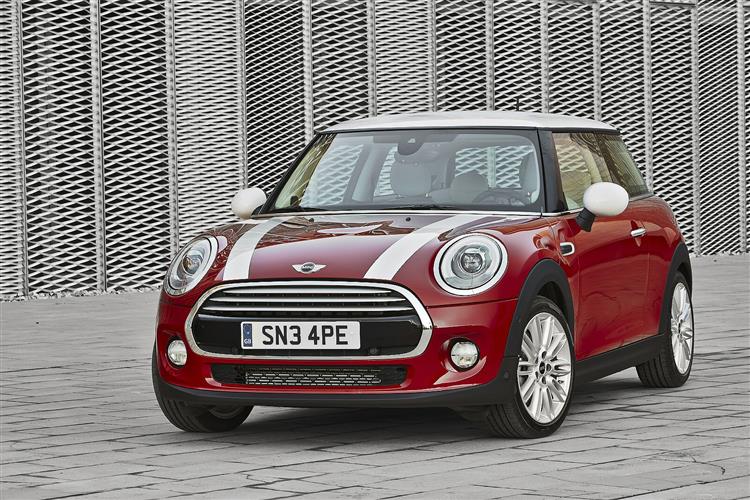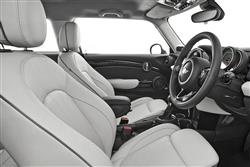HATCHING A SMARTER PLAN (some text hidden) --NONE--
By Jonathan Crouch
Introductionword count: 84
Third time round, BMW's modern era MINI turned out to be a much more sophisticated thing. This three-door Hatch version is slightly more practical than its R56-series predecessor and feels considerably better built. It's far more efficient too, with the bulk of the range using a punchier range of eager three cylinder engines. And its more sophisticated underpinnings are better suited to longer journeys. In short, this car came of age in third generation form. But does it make sense as a used buy?
Modelsword count: 17
3dr Hatch (1.2, 1.5, 2.0 petrol/ 1.5 diesel [One, Cooper, Cooper D, Cooper SD, Cooper S, JCW])
Historyword count: 439
'The MINI is a way of life. A friend. It holds a special place in our hearts'. We're quoting from BMW, who of course are makers of the modern era model, but the words could have come from Alec Issigonis, designer of the 1959 original. That car was never fundamentally changed in nearly half a century of production. This one, in contrast, reached its third generation quite quickly - in 2014 - and was first launched in the three-door Hatch F56 form we're going to look at here. The MK3 MINI offered us a fresh chapter in a modern era success story. By the time of its introduction, over 2.4 million first and second generation versions of what we could call the 'Ger-MINI' had rolled out of the British Oxford factory gates since the day that this car was originally re-launched by BMW in 2001, before being thoroughly updated again in 2006 second generation modern form. These two initial BMW-funded designs proved just how much people were prepared to pay for a small, cute runabout with quality, style and its own cheeky brand of class. Inevitably, they also prompted a whole host of imitators, most with this three-door Hatch version firmly in their sights. Whether you're talking city scoots like the Fiat 500 or the Toyota iQ, smart superminis like the Citroen DS3 and the Alfa MiTo or even trendy small Crossovers like the Nissan Juke or Kia Soul, all claimed inspiration from this car and targeted much the same fashion-conscious customers. People now wanting a bit more than simply trendy design and a bit of fun behind the wheel. By 2014, they were also people wanting a little more luxury, from a car more comfortable in venturing further afield. Driving efficiency and interior space also figured a little higher up customer wish lists than had been the case with previous generation MINI Hatch models. All of which, in developing the MK3 F56 model, left BMW needing to turn a fresh page in the colourful history of this iconic car. You might think that it looks much the same as the previous R56 version but in fact, almost everything was changed for the F56 - the platform, the engines, the technology: all was re-invented. Impressively, the MINI makers managed to achieve all this while still retaining most of the same effervescent MINI character. A five-door F55 version of this design was launched in 2015 and both body styles sold steadily until MINI announced a light mid-term facelift in the Spring of 2018. It's the earlier pre-facelift three-door F56 Hatch model that we look at here as a used buy.
What You Getword count: 1037
It's hard to think of another car on sale today whose sales are influenced quite as directly by the way it looks as this one. Given that aesthetically, the worst mistake any MINI can make is to lose its 'MINI-ness', the job of re-interpreting this car for a fresh generation of buyers must always be a thankless one. Was it successfully carried through here? Inevitably, not everyone thinks so. The need for things like a higher bonnet line to meet modern era pedestrian safety legislation is one of the reasons why it's certainly not as cute, either as the original Issigonis design or the earliest turn of the century Frank Stephenson-styled BMW version. But that said, there's quite enough brand DNA here to make this car as instantly recognisable as anything on the road. The reason why is that all the visual cues you'd expect to see have been perfectly preserved in the move to modernity: the circular headlights (offered with lovely optional LED rings), the clamshell bonnet, the upright windscreen, the blacked-out pillars that create the 'floating' roof and the continuous band of chrome at the base of the glasshouse. All of it's present and correct. The Cooper S version even has the potent bonnet scoop of its predecessors, though MINI will quietly admit that this styling flourish hasn't been functional since the old supercharged car bit the dust in 2006. Just think of it as a way of telling the flagship models apart from the rest at a glance. This MK3 'F56' 3-door Hatch model is a fair bit bigger than its MK2 ''R56' predecessor, a car which still had its roots in the Munich maker's original 2001 'R50' MINI. It's 44mm wider and 7mm taller than before: and 98mm longer too, though unfortunately most of that length gain has been swallowed up by the lengthier front overhang needed to meet the tougher pedestrian impact standards we mentioned earlier. Still a 28mm-longer wheelbase means that the passenger compartment is usefully bigger than before. Access to the rear is easier is certainly easier than it was previously and once you get there, you'll find that the cabin gained some much needed head and legroom in MK3 form. There's more room for shoulders too, though still not enough to make it feasible for MINI to fit more than a couple of seatbelts on the rear bench. No, despite the welcome reclining function for the backrest, you still wouldn't want to be stuck in the back for a long journey but yes, it is a big improvement and kids will be more than happy. One six-footer could here sit behind another with genuinely passable comfort. So in this form, at last, this MINI can be seen, for short trips at least, as a genuine four-seater, rather than a 2+2. That's a big change over what went before. As is the boot capacity, the aspect that, more than any other, MINI owners previously most moaned about. With this F56 model, you get one of those clever moveable floors that can be set at two separate heights (though the downside to that is the lack of a proper spare wheel). Plus the room available increased by more than 30% to 211-litres. OK, so that's still not what you'd call huge and is still miles behind what you'd get in a more practically-shaped trendy rival like a Volkswagen Beetle or a Citroen DS3, let alone an ordinary Fiesta-sized supermini. But the changes made here at least elevated this space beyond the 'Point And Laugh' category. It's certainly a lot bigger than you'd get in a rival Fiat 500 and not too far of the kind of room delivered by potential competitors like Alfa's MiTo and Nissan's Juke. In fact, there's actually more room than you'd get in either of those two models if you push forward the rear bench. Plus it helps that the angle of the backrest can be altered and that it splits 60:40, rather than 50:50: which makes it easier to get awkwardly-shaped items like pushchairs in. With everything flat, a surprisingly large 731-litre load capacity reveals itself. But you don't buy this car for its practicality. Or if you do, then you don't buy this three-door Hatch version anyway. No, what you probably want is a more mature interpretation of 'MINI-ness' - which this MK3 model perfectly delivers. It's easy to forget quite how flimsy a lot of the fittings on the early BMW MINIs were. Remember those indicator stalks that felt like snapping biros? Or the second generation car's feeble little plastic joystick that was used to enter sat nav instructions? Everything feels a good deal more substantial in this car, a good deal more grown up. To that end, you get much more supportive seats with a wider adjustment range and a base lengthened by 23mm for additional comfort and support. There's a proper rotary controller for the lights. Electric window switches re-located to the doors where everyone else puts them. More interior stowage space, with two gloveboxes, additional cup holders and space in the seatbacks and front passenger foot well for the storage of bottles and maps. Oh and a whole series of lovely touches. Like the way the start/stop tab features a heartbeat illumination which pulses before the engine is started. Or the LED perimeter lights of the central display that progressively light up the perimeter of the screen as you switch driving modes, engage the engine stop/start, cope with parking or count down to your next sat nav turn off. That huge display here no longer functions as a speedo - less characterfully but more practically, the speedometer gauge for MK 3 models was re-located to a pod in front of the steering wheel where it's flanked with a crescent-moon rev counter and fuel gauge. All of this freed the central dash area up for much more infotainical trickery, marshalled via optional 6.5 or 8.8-inch multifunction colour displays that most original owners tried to find the extra for since the alternative was a cheapskate-looking four-line TFT read-out. Though crying out for touch screen functionality, the colour layouts are actually marshalled by a classy, effective iDrive-style controller down by the (thankfully conventional) handbrake.
To see the full road test text contact us on 0330 0020 227
Pictures (high res disabled)

.jpg)
|
.jpg)
|
.jpg)
| |||
.jpg)
|
.jpg)
|
.jpg)
| |||
.jpg)
|

|
Scoring (subset of scores)
Category: Small Runabouts
| Performance | |
| Handling | |
| Comfort | |
| Space | |
| Styling, Build, Value, Equipment, Depreciation, Handling, Insurance and Total scores are available with our full data feed. | |



